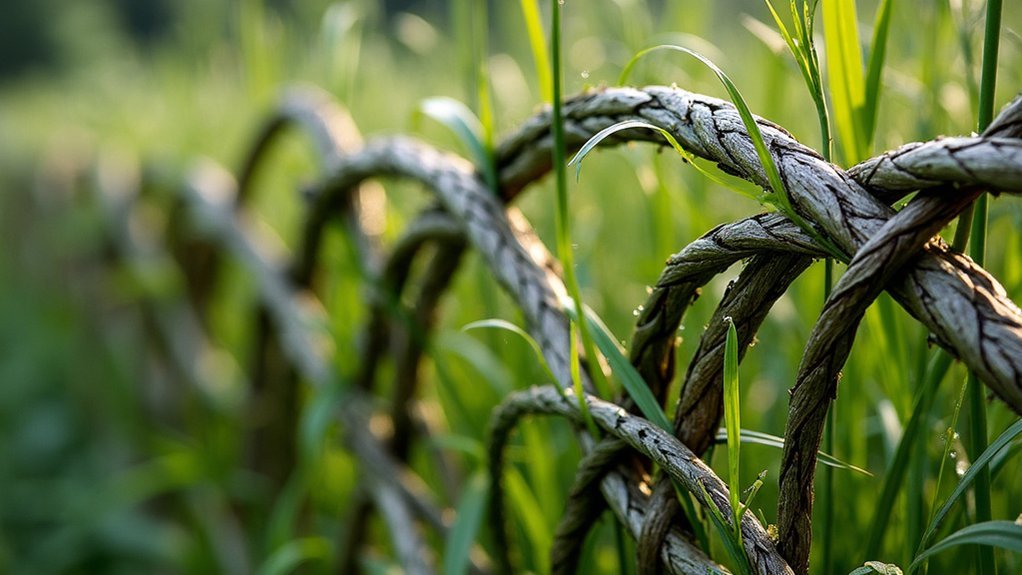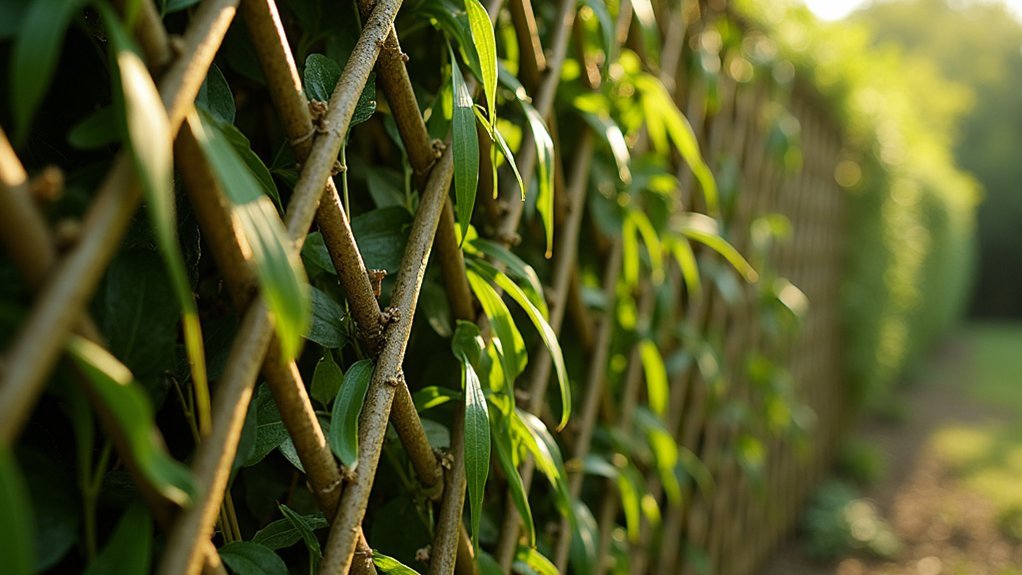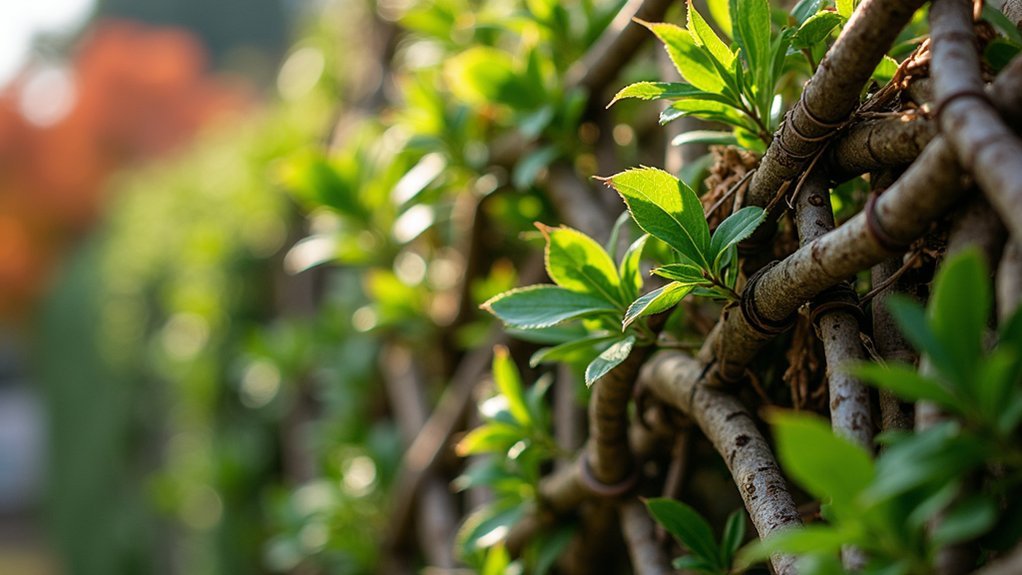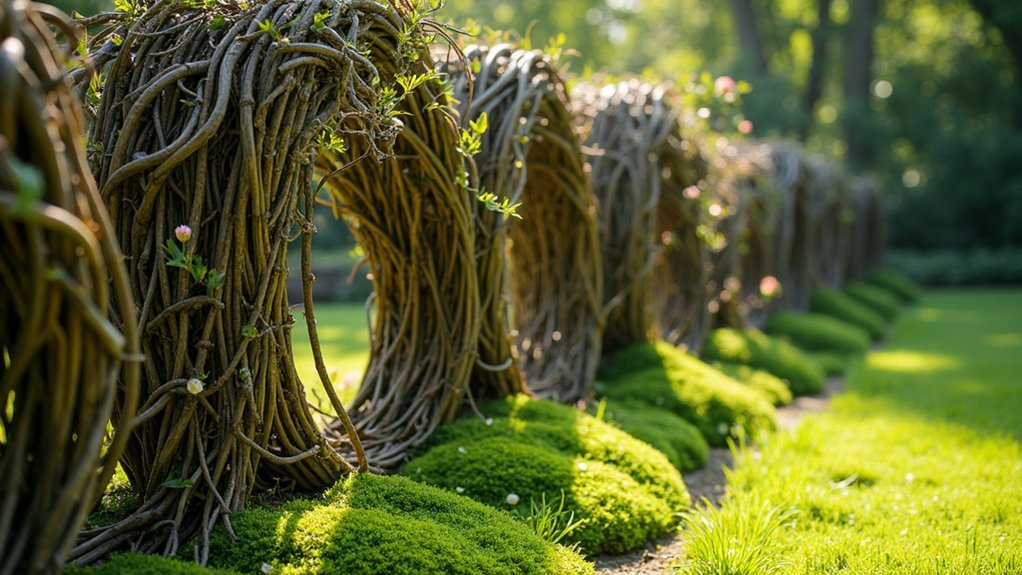Living willow fences blend art with function through careful selection and creative weaving. You’ll need sun-loving varieties like Salix viminalis, planted in well-prepared soil away from utilities. Start with basic lattice patterns before advancing to diamond designs, using thicker rods for support and thinner ones for decorative elements. Regular pruning in late autumn maintains shape while complementary plants add visual interest. The techniques ahead will transform your ordinary boundary into a living sculpture.
The Art of Willow Selection: Varieties for Sculptural Fences

While many gardeners overlook the importance of proper willow selection, choosing the right variety forms the foundation of any successful living fence. Traditional species like Salix viminalis and Salix fragilis offer exceptional flexibility and strength needed for weaving intricate designs.
You’ll want to source disease-resistant varieties from established specialists like Musgrove Willows, who’ve perfected cultivation techniques over generations. Consider hybrid willows for quicker establishment, particularly if you’re keen to see results sooner.
Each Salix species brings unique characteristics to your project—some provide vibrant stem colors while others contribute to local biodiversity by attracting wildlife.
Whatever varieties you choose, make sure they’ll thrive in your specific conditions. Most willows prefer moist soil and full sunlight to develop robust growth and maintain their distinctive visual appeal.
Site Preparation and Planning for Living Willow Boundaries
With your willow varieties selected, your attention must now turn to the ground beneath your feet. Choose a site preparation area that receives full sunlight, which enhances stem color and promotes vigorous growth.
Keep your planting area away from underground pipes—willow’s moisture-seeking roots can cause drainage headaches later.
Thoroughly clear the soil of debris and make certain it’s moist but not waterlogged before installation. Implement effective weed prevention using mulch or weed mats to protect your young willows from nutrient competition.
Before breaking ground, draft a detailed design plan that considers your fence’s ultimate height and visual appeal.
Determine your preferred weaving technique and appropriate spacing between cuttings to guarantee structural soundness. Well-planned willow structures require thoughtful preparation—the time you invest now will shape your living fence’s success for years to come.
Weaving Patterns: From Basic Lattice to Advanced Designs

Once your willow cuttings have been firmly planted, you’ll need to master various weaving techniques to create a sturdy, visually striking fence. Start with basic lattice weaving, using the simple over-under technique that’s perfect for beginners while providing fundamental structural integrity.
As you gain confidence, experiment with advanced designs like diamond patterns that incorporate vertical uprights. These not only prevent sagging but greatly strengthen your living willow fence.
Try adding horizontal weaves at varying heights to introduce flexibility in both spacing and size.
Don’t be afraid to customize your creation—the beauty of willow fences lies in their adaptability. Different weaving patterns create stunning visual effects that transform ordinary boundaries into artistic garden features.
With practice, you’ll develop a personal style that balances creative customization with practical functionality.
Structural Support Techniques for Elaborate Fence Forms
Three key elements form the foundation of any elaborate willow fence design: stability, flexibility, and growth potential.
When creating complex structures, you’ll need to incorporate thicker rods as vertical supports while using thinner willow for decorative elements. Diagonal weaves interlaced with these uprights enhance structural integrity and prevent sagging over time.
For ambitious designs, consider:
- Implementing a lattice weave technique that promotes new growth while providing essential flexibility and movement in response to wind and weather.
- Anchoring your creation with a sturdy framework of hazel or chestnut at the base for permanent support.
- Establishing a regular pruning schedule to maintain shape and encourage dense foliage that strengthens the overall structure.
Seasonal Maintenance to Preserve Artistic Expression

Living willow fences demand attention throughout the year if you’re serious about maintaining their artistic integrity and structural beauty.
Perform seasonal pruning in late autumn to maintain shape and prevent sagging from excessive weight, while encouraging healthy growth in spring.
Monitor soil moisture consistently, ensuring your willows receive adequate water without becoming waterlogged.
Apply a balanced fertilizer like tomato feed or bone meal in early spring to support vibrant development that enhances your artistic expression.
Feed your living willow in spring with balanced nutrients to unleash its full artistic potential.
Don’t overlook mulching around the fence base for effective weed suppression and moisture retention.
During the growing season, regularly inspect for pests or disease signs—early intervention is essential for disease prevention.
These maintenance practices aren’t just about keeping willows alive; they preserve the sculptural integrity of your living art while promoting lush, dense foliage.
Integrating Complementary Plants and Materials for Enhanced Aesthetics
While maintaining your willow fence’s structure creates the foundation for success, adding complementary elements transforms it from a simple boundary into an enchanting garden feature. Your living willow fence becomes a dynamic canvas when paired with thoughtfully selected companions.
Consider these planting techniques to enhance aesthetics:
- Weave flowering climbers like honeysuckle or clematis through the willow structure, adding seasonal color bursts and enticing fragrances.
- Plant aromatic companion plants such as lavender or sage at the fence base to attract pollinators while creating textural contrast.
- Incorporate native grasses alongside decorative materials like natural stone to promote biodiversity and create habitat for local wildlife.
For maximum functionality, try vertical gardening by tucking herbs into the willow weave—this technique optimizes space while adding culinary benefits to your living sculpture.
Frequently Asked Questions
How Do You Make a Living Willow Fence?
You’ll need to select healthy willow rods, plant them 6-8 inches deep in moist soil, space them 6-12 inches apart, weave them together in patterns, and prune regularly to maintain shape.
What Is the Best Willow Species for Living Structures?
For living structures, you’ll find Salix viminalis (common osier) is your best choice due to its rapid growth and flexibility. Salix purpurea and Salix alba also work well for their purple stems and sturdiness respectively.
How Long Does It Take to Grow a Living Willow Structure?
You’ll see initial growth in just weeks after planting. Your living willow structure will take 3-5 years to fully establish, though proper maintenance and choosing fast-growing hybrids can speed up the process.
How Long Do Willow Sculptures Last?
Your willow sculptures can last 5-20 years depending on species, care, and environment. With regular pruning and proper maintenance, you’ll extend their lifespan. Ideal soil moisture and sunlight greatly improve their durability and longevity.
In Summary
You’ve now mastered the art of living willow fences! With proper selection, creative weaving patterns, and regular maintenance, your sculptural boundary will thrive for years. Don’t forget to experiment with complementary plantings to enhance your design. As you watch your living fence grow and evolve, you’ll enjoy not just a boundary, but a dynamic, artistic expression that changes with the seasons.





Leave a Reply